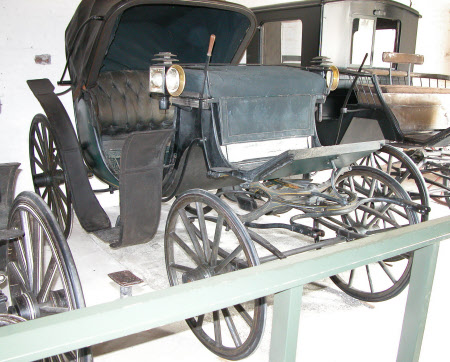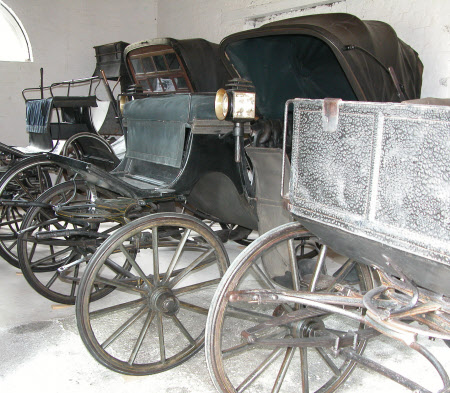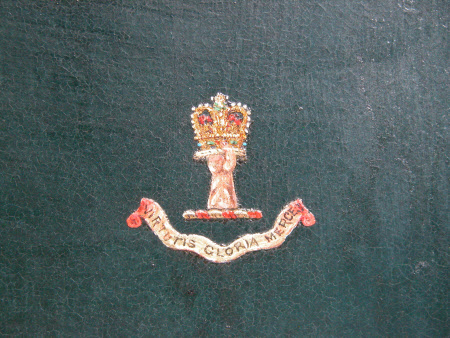Panel boot victoria
Allen & Co.
Category
Carriages & other vehicles
Date
1880 - 1920
Materials
Painted wood body with wool cloth and morocco leather upholstery and four rubber shod wheels.
Measurements
211 x 337 x 174cm (6ft 11in x 11ft 3/4in x 5ft 8 1/2in)
Place of origin
London
Order this imageCollection
Erddig, Wrexham
NT 1152605
Caption
Victorias are open carriages with a leather hood, driven by a coachman with a footman sitting next to him. The low comfortable body carries two, or occasionally three if it has a folding seat stowed in the back of the boot. The low access, elegant style and comfortable seating made the Victoria very popular with ladies for fine weather use. The remains of the original upholstery and trimming give the impression that this was once a lovely carriage.
Summary
Carriage. A panel boot Victoria built between 1880 and 1920 by Allen & Co of Long Acre, London, their number 449. With 12 and 14 spoke English pattern wheels on Collinge axels - all loose. A delicate light fore-carriage, the remains of trimming with attractive laces. Of typical form with a low, hooded body to accommodate two passengers with a drop-down seat fitted in the boot structure. The side panels bear the crest of a fist holding a crown with motto ‘Netutis Gloria Merces’ for the Robertson family of Llandyila and Pale Hall. Made to be drawn by a single or pair of horses. The body has a curved profile and is sprung on elliptic springs the dashboard is missing. This carriage has a leather head and two candle lamps fitted. Upholstered in dark green morocco leather and wool cloth. The body is painted in a livery of black with dark green undercarriage and wheels with black and yellow lining. Crest on the side panels. The remains of the original upholstery and trimming give the impression that this was once a lovely carriage. Victorias are open carriages with a leather hood, driven by a coachman with a footman sitting next to him. The low comfortable body carries two, or occasionally three if it has a folding seat stowed in the back of the boot. The low access, elegant style and comfortable seating made the Victoria very popular with ladies for fine weather use.
Full description
Carriage. A panel boot Victoria built between 1880 and 1920 by Allen & Co of Long Acre, London, their number 449. With 12 and 14 spoke English pattern wheels on Collinge axels - all loose. A delicate light fore-carriage, the remains of trimming with attractive laces. Of typical form with a low, hooded body to accommodate two passengers with a drop-down seat fitted in the boot structure. The side panels bear the crest of a fist holding a crown with motto ‘Netutis Gloria Merces’ for the Robertson family of Llandyila and Pale Hall. Made to be drawn by a single or pair of horses. The body has a curved profile and is sprung on elliptic springs the dashboard is missing. This carriage has a leather head and two candle lamps fitted. Upholstered in dark green morocco leather and wool cloth. The body is painted in a livery of black with dark green undercarriage and wheels with black and yellow lining. Crest on the side panels. The remains of the original upholstery and trimming give the impression that this was once a lovely carriage. Victorias are open carriages with a leather hood, driven by a coachman with a footman sitting next to him. The low comfortable body carries two, or occasionally three if it has a folding seat stowed in the back of the boot. The low access, elegant style and comfortable seating made the Victoria very popular with ladies for fine weather use.
Provenance
Given by Philip Yorke III (1905-1978) along with the estate, house and contents to the National Trust in 1973.
Marks and inscriptions
On front nearside axle cap.: ALLEN LONG ACRE On front offside axle cap.: ALLEN LONG ACRE On rear nearside axle cap.: ALLEN LONG ACRE On rear offside axle cap.: ALLEN LONG ACRE On central board of principal seat.: 449 On front edge of the coachman's seat.: 449
Makers and roles
Allen & Co., carriage builder


